How to feed a child so that studying is not a burden, but a joy, what foods should be given special preference, and why older students should eat less often than first-graders, we were told by Natalia Batsukova, associate professor, head. Department of General Hygiene, Belarusian State Medical University, Candidate of Medical Sciences
The actual diet of a schoolchildren largely depends on what healthy eating habits we, parents, have managed to instill in our children. After all, it is at school age that the craze for “fast food” begins for children, and for high school girls, unhealthy diets for weight loss. Therefore, in anticipation of the school season, let me give you general recommendations on rational nutrition school age children.
The physiological needs of school-age children for energy and basic nutrients (“Norms of physiological needs for nutrients and energy for various groups child population of the Republic of Belarus”, 2002)
|
Children's age
|
Average energy requirement of children, kcal/day
|
Recommended protein intake, g/day
|
Recommended amount of fat intake, g / day |
Recommended amount of carbohydrate intake, g / day
|
|
| total | including the animal | ||||
| 6 years (schoolchildren) | 1900-2000 | 66-75 | 43-49 (65%) | 63-71 | 256-280 |
| 7-10 years old | 2100-2300 | 74-87 | 44-52 (60%) | 70-82 | 284-322 |
| 11-13 years old (boys) | 2400-2700 | 84-102 | 51-61 (60%) | 80-96 | 324-378 |
| 11-13 years old (girls) | 2300-2500 | 81-94 | 49-56 (60%) | 77-89 | 311-350 |
| 14-17 years old (boys) | 2800-3000 | 98-113 | 59-68 (60%) | 93-107 | 378-420 |
| 14-17 years old (girls) | 2400-2600 | 84-98 | 50-59 (60%) | 80-92 | 339-384 |
In the mode of a younger student, 5 meals a day should be maintained. High school students can move on to 4 meals a day. It is important that the child does not refuse the mandatory hot breakfast at school, which should be held after the 2nd or 3rd lesson.
A sample menu for a younger student might look something like this:
1st breakfast:
porridge (vegetable dish); coffee (tea, milk).
2nd breakfast: egg (curd) dish; coffee (tea, milk).
Dinner: salad; first course; meat dish (poultry, fish); garnish; drink.
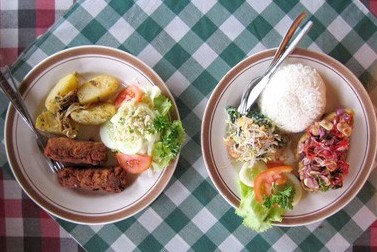 As a first course, a schoolchild can prepare broths (chicken, meat, fish); soups on these broths, seasoned with vegetables, cereals, dumplings, dumplings; vegetarian soups; milk and fruit soups. The second dish can be cutlets, meatballs, meatballs, various vegetable stew with meat, fish, poultry, all kinds of casseroles, baked fish, poultry, stew, azu, goulash, beef stroganoff .
As a first course, a schoolchild can prepare broths (chicken, meat, fish); soups on these broths, seasoned with vegetables, cereals, dumplings, dumplings; vegetarian soups; milk and fruit soups. The second dish can be cutlets, meatballs, meatballs, various vegetable stew with meat, fish, poultry, all kinds of casseroles, baked fish, poultry, stew, azu, goulash, beef stroganoff .
Afternoon snack: kefir (milk); whole grain biscuits or breads; fresh fruits.
Dinner: vegetable (curd) dish or porridge; milk (kefir).
When building a diet for children, it is necessary to monitor the correct distribution of products during the day. Protein-rich foods, especially when combined with fat, stay longer in the stomach and require much more digestive juices to digest. In addition, meat products are rich in extractive nitrogenous substances that excite the central nervous system. nervous system and such a dinner can lead to restless sleep of the child, or in general, to insomnia. Therefore, dishes from meat, fish, eggs should be used in the first half of the day, and dairy and vegetable dishes, which are much easier to digest, for dinner, since digestion slows down at night during sleep.
Particular attention in the nutrition of a schoolchild should be paid to the protein component of the diet, while at least 60% of proteins of animal origin should be accounted for. The needs of a growing child's body are best met by milk protein, and therefore milk and dairy products are considered as a mandatory product that cannot be replaced. baby food. For school-age children, the daily norm of milk (kefir, etc.) is 500 ml. Keep in mind that 100 g of milk corresponds to 12 g of powdered milk or 25 g of condensed milk. Give preference to better enriched dairy products - with the addition of vitamins, iodized protein, lactulose, bifidobacteria. By the way, boiling milk reduces its biological value (amino acids are destroyed), it is better to drink pasteurized and ultra-pasteurized milk. Schoolchildren are recommended dairy products with reduced fat content: they have the same amount of calcium and protein as in fatty foods, and the degree of their assimilation is better.
The most important growth amino acids are lysine, tryptophan and histidine, so it is important that the student's diet contains their sources - meat, fish, eggs, cottage cheese, cheese, squid, legumes.
 It is rational to eat meat (poultry) 2-3 times a week, alternating it with fish. At the same time, it is better to cook dishes from beef fillet, veal, lean pork in boiled and baked form. Schoolchildren, especially younger age, it is worth limiting fried, smoked, sausages (the latter are rich in salt, "hidden" fats and contain sodium nitrite). Before cooking meat, it is best to trim visible fat and remove skin from poultry. And, if you sometimes fry meat for a child, then it is better to do it in a pan with a grate so that the fat drains into the pan or, after frying, put the product on a clean napkin to absorb excess fat. Refrigerate soups and stews, and then skim off any fat that has hardened on the surface. An important advantage of meat is the large amount of easily digestible iron in it (unlike the iron of vegetables and fruits), which is especially necessary for high school girls, otherwise the risk of developing iron deficiency anemia increases. Another mandatory protein product in the diet of a student is fish. Fish proteins are broken down by digestive enzymes faster and easier than beef proteins, because. do not contain connective tissue proteins (elastin). Fish is rich in high-value 3-omega fatty acids, vitamins D, A, group B, minerals K, S, P, J, Zn, Fe, Cu, etc. There is a lot of methionine in fish, which improves the proper absorption (and not accumulation) of fats . Schoolchildren should limit their diet to salted, canned, dried, smoked fish, because. it is rich in uric acid salts and sodium, which can contribute to joint disease and the development of hypertension in a child. Preference should be given to sea fish and seafood (if the child does not have allergies), as they are a source of iodine, which is necessary to improve intellectual development schoolchild and prevention of goiter. By the way, as an additional source of iodine, try grinding dry sea kale and add it instead of salt in dishes. When cooking fish, in order to destroy the specific smell (which many children do not like so much) of flounder, cod, halibut and other sea fish during cooking, it is good to add cucumber pickle to the broth, in addition to roots and onions (½ - 1 cup per 1 liter of water) . And to eliminate the smell when frying fish, you need to put a few slices of peeled raw potatoes in a pan in vegetable oil.
It is rational to eat meat (poultry) 2-3 times a week, alternating it with fish. At the same time, it is better to cook dishes from beef fillet, veal, lean pork in boiled and baked form. Schoolchildren, especially younger age, it is worth limiting fried, smoked, sausages (the latter are rich in salt, "hidden" fats and contain sodium nitrite). Before cooking meat, it is best to trim visible fat and remove skin from poultry. And, if you sometimes fry meat for a child, then it is better to do it in a pan with a grate so that the fat drains into the pan or, after frying, put the product on a clean napkin to absorb excess fat. Refrigerate soups and stews, and then skim off any fat that has hardened on the surface. An important advantage of meat is the large amount of easily digestible iron in it (unlike the iron of vegetables and fruits), which is especially necessary for high school girls, otherwise the risk of developing iron deficiency anemia increases. Another mandatory protein product in the diet of a student is fish. Fish proteins are broken down by digestive enzymes faster and easier than beef proteins, because. do not contain connective tissue proteins (elastin). Fish is rich in high-value 3-omega fatty acids, vitamins D, A, group B, minerals K, S, P, J, Zn, Fe, Cu, etc. There is a lot of methionine in fish, which improves the proper absorption (and not accumulation) of fats . Schoolchildren should limit their diet to salted, canned, dried, smoked fish, because. it is rich in uric acid salts and sodium, which can contribute to joint disease and the development of hypertension in a child. Preference should be given to sea fish and seafood (if the child does not have allergies), as they are a source of iodine, which is necessary to improve intellectual development schoolchild and prevention of goiter. By the way, as an additional source of iodine, try grinding dry sea kale and add it instead of salt in dishes. When cooking fish, in order to destroy the specific smell (which many children do not like so much) of flounder, cod, halibut and other sea fish during cooking, it is good to add cucumber pickle to the broth, in addition to roots and onions (½ - 1 cup per 1 liter of water) . And to eliminate the smell when frying fish, you need to put a few slices of peeled raw potatoes in a pan in vegetable oil.
If your child prefers egg dishes, then in order not to overload his body with cholesterol (by the way, the recommended number of eggs is no more than 4-5 pieces per week), you can use 2 egg whites instead of 1 whole egg when preparing egg dishes (and yolks can be freeze and use in baking).
 An important addition to the protein part of the schoolchildren's diet are legumes and nuts. A student can always have a bag of nuts and dried fruits in his briefcase for an “express snack”.
An important addition to the protein part of the schoolchildren's diet are legumes and nuts. A student can always have a bag of nuts and dried fruits in his briefcase for an “express snack”.
The fat content in a schoolchild's diet should be optimal (see table). A lack of fat can lead to a decrease in immunity, and an excess can lead to metabolic disorders, poor protein absorption, and indigestion.
The best sources of carbohydrates in the diet of schoolchildren are fruits, vegetables and cereals. Every day, fruits and vegetables of green, yellow (orange), red (burgundy) color should be on the table, then almost all vitamins, microelements and biologically active substances necessary for the body (indoles, polyphenols, lycopene, chlorophyll, etc., which give a particular color to the plant and at the same time perform important functions in the body). In general, a student should consume at least 400 g of vegetables and fruits per day. With meat and fish dishes as a side dish, it is better for a child to give juicy vegetables: lettuce, spinach, chard (leaf beet), all types of cabbage, asparagus, zucchini, pumpkin, onions, radishes, cucumbers. By the way, everyone's favorite salad of fresh cucumbers and tomatoes is not a standard of optimal combination for the reason that ascorbic acid, which is rich in tomatoes, is easily destroyed by the enzyme ascorbate oxidase, which comes out of chopped cucumbers. In extreme cases, this salad should be prepared for one meal and eaten immediately.
Be sure to control the child's consumption of confectionery and buns (often children buy them during breaks and on the way from school): their excess content in the diet can contribute to the development of metabolic disorders, which leads to allergies, diabetes and obesity.
In order for the processes of digestion in a student to pass without tension, some factors must be taken into account. Thus, the slowing effect of fat on gastric secretion (especially mutton fat and margarine) has been proven. This slows down protein digestion by 2 hours or more. The slowing effect of fat on gastric secretion can be eliminated by consuming a large amount of green vegetables, preferably raw. Raw cabbage is especially effective in this regard. For this reason, green vegetables go well with cheese, meat, and nuts. Also, the intensity of digestion of food is reduced by the child's habit of washing down the dish with water - while the digestive juice is diluted and the concentration of digestive enzymes decreases, which also lengthens and complicates digestion.
Inna Izotova, especially for
Recipes:
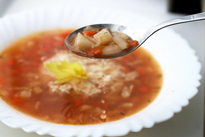
If you notice a mistake in the text, please highlight it and click Ctrl+Enter
Purpose: to consolidate theoretical knowledge in the section "Hygienic requirements for the nutrition of schoolchildren" and acquire practical skills in compiling a daily school menu. Tasks: - to master the age standards of food substances and products for schoolchildren according to the tables and text; - determine the balance of the diet for proteins, fats, carbohydrates; - to determine the optimality of the diet in accordance with the training shift at school and the motor mode of the student; - determine the compliance of the student's menu with the basic principles of healthy eating. Required: tables of average daily energy consumption of schoolchildren of different age groups, food calorie tables recommended for schoolchildren, a calculator. The order of the task: according to the given tables with the standard values of the most important nutrients, draw up a daily menu for a student of a certain age group (junior, middle) senior school age) taking into account the peculiarities of the student's motor mode (does he go in for sports or not). Theoretical substantiation of the topic. The recommended intake of energy and essential nutrients is presented in Table. 11. The need for animal protein should be covered by 65% of the daily requirement for 6-year-old children and 60% for children over 7 years of age. The combination of animal and vegetable fats in the daily menu should be 80% and 20%, respectively. Complex carbohydrates should be 4 times more than simple ones. The ratio of proteins: fats: carbohydrates is 1: 1: 4 (for younger students - 1: 1: 6). At the same time, simple carbohydrates prevail in the diet of the population of the Tula region, including children, which predisposes to pancreatic dysfunction and metabolic disorders (obesity).
Baby food is often overloaded with carbohydrates due to an excess of confectionery, sugar, pasta, flour products, bread. Excess carbohydrates turn into fat, creating excess weight; sugar poses a risk of developing caries. Vitamins and minerals play an important role in healing the body through nutrition. As a rule, they are not reproduced in the body and must be supplied with food (Tables 12, 13). In modern schoolchildren, vitamin deficiency occurs only in the group of homeless children, but hypovitaminosis (vitamin deficiency in nutrition and in the body) is also possible in prosperous families, especially in the winter-spring period, when the content of vitamins in foods decreases due to natural losses. At the same time, the deficiency of B vitamins creates the basis for a decrease in the functional well-being of the nervous system and contributes to the emergence of neuroses. Therefore, during problem periods of the year, artificial fortification of food is necessary (for example, adding vitamins to third courses based on the daily intake) in school canteens or additional intake of multivitamin preparations at an age dosage at home. Not all food taken is absorbed, part of it is thrown out of the intestines in the form of toxins. The digestibility of animal food is on average 95%, vegetable - 80%, mixed - 82-90%. In practice, calculations are made on the basis of 90% of the assimilation of food. Therefore, when calculating the calorie content of food, it should be 10-15% higher than the energy consumption regulated by age.
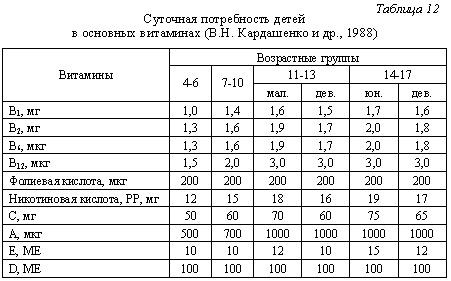
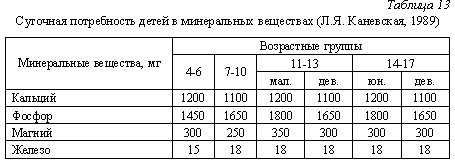
The completeness of the mineral, including microelement, composition of food is very important for optimizing the body's water-salt metabolism (bone-muscle tissue, teeth), and the functions of the endocrine system. Lack of iodine creates thyroid dysfunction (which is typical for the population of the Tula region); a lack of zinc leads to a delay in the growth and puberty of children; lack of iron - to anemia. Fluorine deficiency contributes to the development of caries. The need for water in children 6-7 years old is 60 ml per 1 kg of body weight, in schoolchildren - 50 ml. But one should also take into account the conditions of activity, climatic conditions, etc. Excess and lack of water are equally harmful for the body, since either an overload of the circulatory and excretory system occurs, or dehydration of the body, which creates a dysfunction of water metabolism. In order for the schoolchildren's diet to provide the nutrients necessary for a healthy body, one should adhere to the recommended food intake values \u200b\u200bthat are presented in Table 1 in everyday nutrition. 14. It should only be taken into account that these products are presented in raw unprocessed form. During processing, losses (waste) are inevitable. So, when cooking meat loses 40% of its original weight. At the same time, cereals, legumes and pasta, when cooked, give a "weld" (increase in mass).

Every day, all listed in the table. 14 foods can not be used in nutrition. Part of the products should be present every day (meat, milk, butter and vegetable oil, bread, vegetables, fruits, honey (sugar)), the other part (cheese, eggs, cottage cheese, fish) can be included in meals 2-3 times a week . Of great importance for the student is the diet, which regulates the number of meals, the interval between them, the number of calories per meal, the quality of the usefulness of products for a separate meal, the distribution of the diet by meals during the day (Tables 15, 16).


A 5-time meal is recommended for weakened children with chronic diseases, as well as elementary school students and extended day groups. In addition, it is desirable to organize such meals for schoolchildren during the summer period (holiday), when their energy consumption is much higher than in the winter period (Tables 17, 18).
![]()
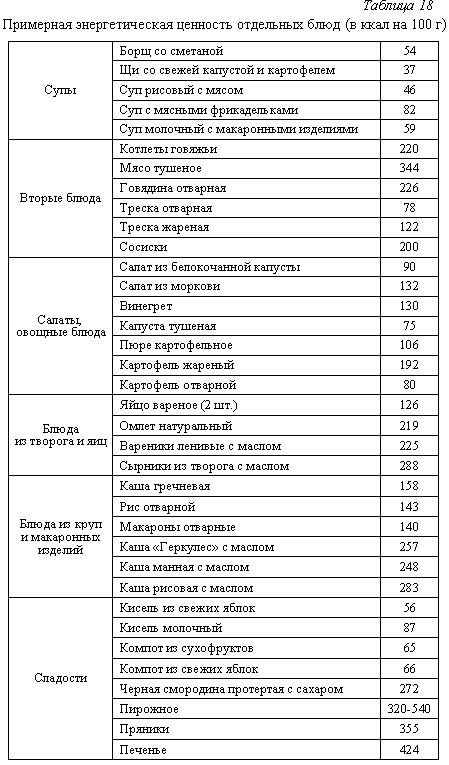
So the summer has flown by! Just a few days left until the first of September. It's time to buy textbooks and notebooks, school uniforms, if needed. And to transfer a child from a summer, more free diet to a “school”, otherwise it will not be easy for him to withstand the training load.
What should be student diet?
According to the advice of doctors, the interval between meals should not exceed 4-5 hours. Breakfast should be 30% of the daily calorie intake, lunch - 35%, afternoon tea - 10-15%, and dinner - 20-25%
As for school food menu, then the recommendations of nutritionists here are.
On breakfast you can offer your child porridge, a dish of eggs, cottage cheese, meat, fish and vegetables.
On dinner it is necessary to give the first course: 2-3 times a week - vegetarian soups, on other days - borscht, soups, cabbage soup on low-fat meat or chicken broth. On the second - a dish of lean pork, beef, 3-4 times a week - chicken or fish dishes. As a side dish, you can offer not only dishes from cereals or pasta, but also a salad of fresh vegetables, especially since in early autumn their choice is great. The third is served compotes, fruit drinks, kissels.
On afternoon tea it is better to offer fermented milk products, juices, fruits, as well as pastries.
On dinner you can cook sandwiches, dishes from cottage cheese, eggs, casseroles, fish with vegetables, jelly, juice or compote. But fatty meat, legumes, sweets, flour, soda is undesirable to give a child. And, of course, do not offer him coffee, strong black tea, chocolate, cocoa, cola before bedtime (they contain caffeine, which “invigorates” the nervous system and increases the activity of the body).
He needs to have dinner no later than 1.5-2 hours before going to bed, and the break between dinner and breakfast the next day should not be more than 12 hours. If the child is hungry before going to bed, you can offer him a glass of milk, bifidoc, narine.
Such a diet provides a healthy diet for schoolchildren. But of course, these are just general guidelines. After all, the student's diet depends not only on the academic load, but also on classes in various circles and sections, depending on the schedule of which the hours of eating can change. Still, you need to strive to ensure that the child develops the habit of eating at a certain time.
What else needs to be considered in order to ensure proper nutrition schoolchildren? It is especially important that children get enough protein. If the protein comes from food in insufficient quantities, the immune system suffers first of all, which loses the ability to renew cells in a timely manner. With a deficiency of animal protein (and it should be at least 50% of the total amount of protein), it is difficult for children to cope with academic loads, their performance decreases, they get tired faster.
What foods are high in animal protein? This
- cow and goat milk,
- fermented milk products: kefir, yogurt, curdled milk,
- cottage cheese, cheeses,
- meat (beef, pork, lamb), poultry and offal,
- river and sea fish,
- eggs.
vegetable protein contain
- legumes (beans, soybeans, lentils, peas)
- cereals, of which buckwheat and oatmeal are the most useful.
Concerning fat, then the need for them is provided by such products as butter, sour cream, cream, vegetable oils. But the so-called soft oils, margarine, it is undesirable for children to use.
The need for vitamins, mineral vegetables and fiber is provided by vegetables and fruits. At this age, children need to eat 5 servings of fruits and vegetables daily.
One serving is:
- 1 medium sized fruit (apple, banana, orange)
- 2 small fruit (like a plum), 10-15 grapes, berries,
- 1 small serving of fresh vegetable salad
- 1 tablespoon dried fruit.
Daily amount of food
- for children 7-11 years old should be about 2.5 kg,
- for children 11-15 years old - 2.5-2.8 kg,
- for teenagers over 15 years old - 2.8-3.0 kg.
- The daily need for fluid is 1.5-2 liters.
To ensure a healthy diet for schoolchildren, nutritionists recommend cooking, steaming, stewing and baking dishes for them. Spicy, fried, fatty, smoked, salty dishes and canned foods should not be given to them. It is also worth limiting the use of sausages, fast food (hamburgers, french fries, etc.), flour products, sweets (including lollipops and chocolate bars), chips, carbonated sweet water, spices and salt. This is especially important when in question about the nutrition of younger students, who should not be given fast food and drinks such as cola at all.
